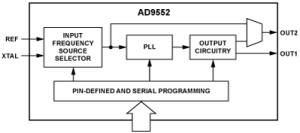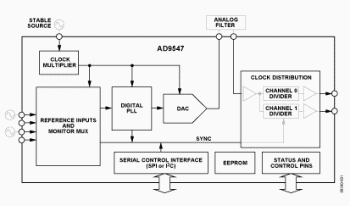Analog Devices Press Release - August 14, 2009 |
ADI Clocking ICs Replace Expensive, High-Frequency VCOs; Improve JitterADI’s AD9552 and AD9547 clock ICs streamline design and lower cost for HDTV, data acquisition, wireless basestations, test-and-measurement, networking and telecommunications applications. The
AD9552 replaces larger, expensive, high-frequency
VCOs (voltage-controlled oscillators), including OCXO (oven-controlled crystal oscillator), VCXO
(voltage-controlled crystal oscillator) and TCXO (temperature-compensated crystal oscillator) devices. The
upconverter requires either a single-ended, low-frequency reference signal or a crystal reference to establish the
higher output frequency the IC generates. It provides ultra-low jitter of under 0.5 ps (picoseconds) operating
with input frequencies in the range of 50 kHz to 80 MHz at half the price of competitive alternatives. The device
can generate almost any desired output frequency up to 900 MHz for a variety of applications, such as HDTV, data
acquisition, wireless basestations, test and measurement, networking and telecommunications. The upconverter
features very low power consumption–less than 400 mW in a compact 5 mm x 5 mm package size. The
AD9552 replaces larger, expensive, high-frequency
VCOs (voltage-controlled oscillators), including OCXO (oven-controlled crystal oscillator), VCXO
(voltage-controlled crystal oscillator) and TCXO (temperature-compensated crystal oscillator) devices. The
upconverter requires either a single-ended, low-frequency reference signal or a crystal reference to establish the
higher output frequency the IC generates. It provides ultra-low jitter of under 0.5 ps (picoseconds) operating
with input frequencies in the range of 50 kHz to 80 MHz at half the price of competitive alternatives. The device
can generate almost any desired output frequency up to 900 MHz for a variety of applications, such as HDTV, data
acquisition, wireless basestations, test and measurement, networking and telecommunications. The upconverter
features very low power consumption–less than 400 mW in a compact 5 mm x 5 mm package size. The AD9552 is a fractional-N, PLL- (phase-locked-loop) based clock generator. The device employs a Σ-Δ (sigma-delta) modulator to accomplish fractional frequency synthesis. The user supplies an input reference signal by connecting a single-ended clock signal to the REF pin or by connecting a crystal resonator across the XTAL pins. The AD9552 is pin-programmable, providing one of 64 standard output frequencies from any of eight common input frequencies. The device also has a 3-wire SPI interface, enabling the user to program custom input-to-output frequency ratios. The AD9552 requires only a 12-nF external capacitor to complete the PLL’s loop filter. The output is compatible with LVPECL, LVDS, or single-ended CMOS logic levels.  AD9547:
Next Generation Clock Synchronizer Offers 66 Percent Better Jitter Performance, up to 100-times Narrower Loop
Filters AD9547:
Next Generation Clock Synchronizer Offers 66 Percent Better Jitter Performance, up to 100-times Narrower Loop
FiltersThe AD9547 is the next generation of the AD9549 – one of ADI's most popular new clock devices in both the wired and wireless telecom markets. When compared to the AD9549, the AD9547 boasts 66 percent better jitter, 100 times narrower loop-filter bandwidths (as narrow as 1 milliHertz) with twice as many inputs and outputs, and it supports Stratum-2 level holdover. The AD9547 also serves any application with remote equipment requiring synchronization to local systems. It generates an output clock that synchronizes to one of two differential or four single-ended external input references saving designers time and money because they no longer need to rely on additional clock distribution chips to complete their clock trees. The AD9547 provides synchronization for many systems, including synchronous optical networks (SONET/SDH). The digital PLL reduces input time jitter or phase noise associated with the external references. The AD9547 continuously generates a clean, low jitter, valid output clock, even when all references have failed, by means of digitally-controlled loop and holdover circuitry. Pricing, Availability and Complementary Parts Product Availability Price Each Per 1,000 Temperature Range Packaging AD9552 NOW $7.65 -40°C to +85°C 5 mm x 5 mm 32-lead LFCSP AD9547 NOW $13.97 -40°C to +85°C 9 mm x 9 mm 64-lead LFCSP Complementary parts include ADI’s clock generator and distribution ICs, such as the AD9549 clock generator, AD9551 clock generator and clock buffers such as ADCLK846, ADCLK854, ADCLK946 and ADCLK954. As part of a signal chain, these clock buffers work well with most of ADI’s data-converter product families, such as the recently announced suite of low-power dual-channel ADCs and AD9789 14-bit TxDAC® transmit DACs. For more information, visit http://www.analog.com/pr/AD9552 and http://www.analog.com/pr/AD9547. For product information on clocks, visit http://www.analog.com/clock-and-timing. About Analog Devices, Inc. Innovation, performance, and excellence are the cultural pillars on which Analog Devices has built one of the longest standing, highest growth companies within the technology sector. Acknowledged throughout the industry as the world leader in data conversion and signal conditioning technology, Analog Devices serves over 60,000 customers, representing virtually all types of electronic equipment. Celebrating over 40 years as a leading global manufacturer of high-performance integrated circuits used in analog and digital signal processing applications, Analog Devices is headquartered in Norwood, Massachusetts, with design and manufacturing facilities throughout the world. Analog Devices' common stock is listed on the New York Stock Exchange under the ticker “ADI” and is included in the S&P 500 Index. For more information on ADI's most recent product releases, visit our Press Release home page. Contacts Analog Devices, Inc. Bob Olson 781-937-1666 bob.olson@analog.com Posted 8/14/2009 |